Kṛṣṇa constructed a Fort in the midst of the Sea
Dvārakā Fort – Kṛṣṇa’s Amazing City
By Mohini Devi Dasi
KB – CHAPTER FIFTY
Kṛṣṇa Erects the Dvārakā Fort
Kṛṣṇa therefore decided to construct a formidable fort in a place where no two-legged animal, either man or demon, could enter. He decided to keep His relatives there so that He would then be free to fight with the enemy. IT APPEARS THAT FORMERLY DVARAKA WAS ALSO PART OF THE KINGDOM OF MATHURA because in the Śrīmad-Bhāgavatam it is stated that Kṛṣṇa constructed a fort in the midst of the sea. Remnants of the fort which Kṛṣṇa constructed are still existing on the Bay of Dvārakā.
He first of all constructed a very strong wall covering NINETY-SIX SQUARE MILES and the wall itself was within the sea. It was certainly wonderful and was planned and constructed by Viśvakarmā. No ordinary architect could construct such a fort within the sea, but an architect like Viśvakarmā, who is considered to be the engineer among the demigods, can execute such wonderful craftsmanship anywhere in any part of the universe.
If huge planets can be floated in weightlessness in the outer space by the arrangement of the Supreme Personality of Godhead, surely the architectural construction of a fort within the sea covering a space of NINETY-SIX SQUARE MILES was not a very wonderful act.
Kṛṣṇa enters the City of Dvārakā
“While entering the city of Dvaraka, Lord Krishna acknowledged all the inhabitants’ by casting His transcendental glance over them. The city was filled with the opulences of all seasons. There were hermitages, orchards, flower gardens, parks and reservoirs of water filled with lotus flowers. The highways, subways, lanes, markets and public meeting places were all thoroughly cleansed and then moistened with scented water, And to welcome the Lord, the residents of Dvaraka strew flowers, fruits and unbroken seeds everywhere. The residents hastened toward the Lord on chariots, upon which rode brahmanas bearing flowers, In front of the chariots were elephants, which are emblems of good fortune. Conchshells and bugles were sounded, and Vedic hymns were chanted. Thus, the residents offered their respects, which were saturated with affection, In return, Lord Krishna, the Personality of Godhead, approached them and offered due honor and respect to each and every one of the friends, relatives, citizens and others who came to receive and welcome Him. As the Lord passed along the public road of Dvaraka, His head was protected from sunshine by a white umbrella. White feathered fans moved in semicircles, and showers of flowers fell upon the road. His yellow garments and garlands of flowers made it appear as if a dark cloud were surrounded simultaneously by the sun, the moon, lighting and rainbows.“
It is stated in the Śrīmad-Bhāgavatam that this new, well-constructed city, developed within the sea, had regular planned roads, streets and lanes. Not only were there well-planned roads, streets and lanes, but there were well-planned paths and gardens filled with plants known as kalpavṛkṣas, or desire trees. These desire trees are not like the ordinary trees of the material world; the desire trees are found in the spiritual world.
By Kṛṣṇa’s supreme will, everything is possible, so such desire trees were planted in the city of Dvārakā constructed by Kṛṣṇa. The city was also filled with many palaces and gopuras, or big gates. These gopuras are still found in some of the larger temples. They are very high and constructed with extreme artistic skill. Such palaces and gates held golden waterpots (kalaśa). These waterpots on the gates or in the palaces are considered to be auspicious signs.
Almost all the palaces were skyscrapers. In each and every house there were big pots of gold and silver and grains stocked in underground rooms. And there were many golden waterpots within the rooms. The bedrooms were all bedecked with jewels, and the floors were mosaic pavements of marakata jewels ( green emerald).
The Viṣṇu Deity, worshiped by the descendants of Yadu, was installed in each house in the city. The residential quarters were so arranged that the different castes, brāhmaṇas, kṣatriyas, vaiśyas and śūdras, had their respective quarters. It appears from this that the caste system was existing even at that time.
In the center of the city there was another residential quarter made specifically for KING UGRASENA. This place was the most dazzling of all the houses.
KB – CHAPTER SIXTY-ONE: The Genealogy of the Family of Kṛṣṇa: Kṛṣṇa had 16,108 wives, and in each of them He begot TEN sons, all of them equal to their father in the opulences of strength, beauty, wisdom, fame, wealth and renunciation. ”Like father like son.“
KB – CHAPTER SIXTY-NINE
The Great Sage Nārada Visits the Different Homes of Lord Kṛṣṇa
The great sage Nārada heard that Lord Kṛṣṇa had married sixteen thousand wives after He had killed the demon Narakāsura, sometimes called Bhaumāsura. Nārada became astonished that Lord Kṛṣṇa had expanded Himself into sixteen thousand forms and married these wives simultaneously in different palaces. Being inquisitive as to how Kṛṣṇa was managing His household affairs with so many wives, Nārada desired to see these pastimes and so set out to visit Kṛṣṇa’s different homes.
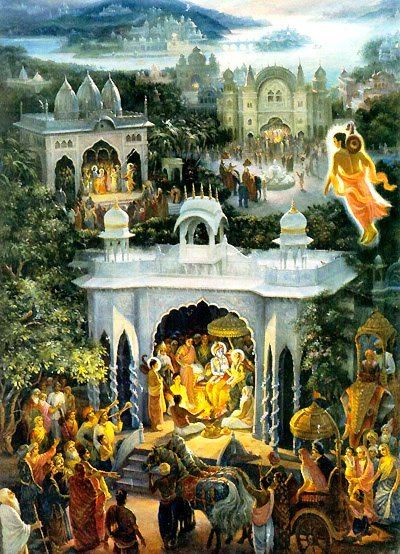
“When Nārada arrived in Dvārakā, he saw that the gardens and parks were full of various flowers of different colors and orchards that were overloaded with a variety of fruits. Beautiful birds were chirping, and peacocks were delightfully crowing. There were tanks and ponds full of blue and red lotus flowers, and some of these sites were filled with varieties of lilies. The lakes were full of nice swans and cranes whose voices resounded everywhere.”
In the city there were AS MANY AS 900,000 GREAT PALACES built of first-class marble with gates and doors made of silver. The posts of the houses and palaces were bedecked with jewels such as touchstone, sapphires and emeralds, and the floors gave off a beautiful luster. The highways, lanes, streets, crossings and marketplaces were all beautifully decorated. The whole city was full of residential homes, assembly houses, and temples, all of different architectural beauty. All of this made Dvārakā a glowing city. The big avenues, crossings, lanes, streets, and also the thresholds of every residential house, were very clean. On both sides of every path there were bushes, and at regular intervals there were large trees that shaded the avenues so that the sunshine would not bother the passersby.
In this greatly beautiful city of Dvārakā, Lord Kṛṣṇa, the Supreme Personality of Godhead, had many residential quarters. The great kings and princes of the world used to visit these palaces just to worship Him.
Lord Śrī Kṛṣṇa was the King of Dvārakā and was known as Dvārakādhīśa.
The architectural plans were made personally by Viśvakarmā, the engineer of the demigods, and in the construction of the palaces he exhibited all of his talents and ingenuity. These residential quarters numbered more than sixteen thousand, and a different queen of Lord Kṛṣṇa resided in each of them. The great sage Nārada entered one of these houses and saw that the pillars were made of coral and the ceilings were bedecked with jewels.
KB – CHAPTER NINETY
Summary Description of Lord Kṛṣṇa’s Pastimes
The concluding portion of Kṛṣṇa’s pastimes is found in the Ninetieth Chapter of the Tenth Canto of Śrīmad-Bhāgavatam, and in this chapter Śukadeva Gosvāmī wanted to explain how Kṛṣṇa lived happily at Dvārakā with all opulences.
Kṛṣṇa’s opulence of strength has already been displayed in His different pastimes, and now it will be shown how His residence at Dvārakā displayed His opulences of wealth and beauty. In this material world, which is only a perverted reflection of the spiritual world, the opulences of wealth and beauty are considered to be the highest of all opulences. Therefore, while Kṛṣṇa stayed on this planet as the Supreme Personality of Godhead, His opulences of wealth and beauty had no comparison within the three worlds.
Kṛṣṇa enjoyed sixteen thousand beautiful wives, and it is most significant that He lived at Dvārakā as the only husband of these hundreds and thousands of beautiful women. It is specifically stated in this connection that He was the only husband of sixteen thousand wives. It is, of course, not unheard of in the history of the world that a powerful king would keep many hundreds of queens, but although such a king might be the only husband of so many wives, he could not enjoy all of them at one time. Kṛṣṇa, however, enjoyed all of His sixteen thousand wives simultaneously.
Although it may be said that yogīs also can expand their bodies into many forms, the yogī’s expansion and Lord Kṛṣṇa’s expansion are not one and the same. Kṛṣṇa is therefore sometimes called Yogeśvara, the master of all yogīs. In the Vedic literature we find that the yogī Saubhari Muni expanded himself into eight. But that expansion was like a television expansion. The television image is manifested in millions of expansions, but those expansions cannot act differently; they are simply reflections of the original and can only act exactly as the original does. Kṛṣṇa’s expansion is not material like the expansion of the television or the yogī. When Nārada visited the different palaces of Kṛṣṇa, he saw that Kṛṣṇa, in His different expansions, was variously engaged in each and every palace of the queens.
Kṛṣṇa with Rukmiṇī
“After defeating all the opposing elements and forcibly carrying away Rukmiṇī, Kṛṣṇa brought her to His capital city, Dvārakā, and then married her according to the Vedic ritualistic principle. After this marriage, Kṛṣṇa became the King of the Yadus at Dvārakā. On the occasion of His marriage with Rukmiṇī, all the inhabitants were happy, and in every house there were great ceremonies. The inhabitants of Dvārakā City became so pleased that they dressed themselves with the nicest possible ornaments and garments, and they went to present gifts according to their means to the newly married couple, Kṛṣṇa and Rukmiṇī. All the houses of Yadupurī (Dvārakā) were decorated with flags, festoons and flowers. Each and every house had an extra gate specifically prepared for this occasion, and on both sides of the gate there were big water jugs filled with water. The whole city was flavored by the burning of high quality incense, and at night there was illumination by thousands of lamps, decorating each and every building.”
The entire city appeared jubilant on the occasion of Lord Kṛṣṇa’s marriage with Rukmiṇī. Everywhere in the city there was profuse decorations of banana trees and betel nut trees. These two trees are considered very auspicious in happy ceremonies. At the same time there was an assembly of many elephants, who carried the respective kings of different friendly kingdoms. It is the habit of the elephant that whenever he sees some small plants and trees, out of his sportive frivolous nature, he uproots the trees and throws them hither and thither. The elephants assembled on this occasion also scattered the banana and betel nut trees, but in spite of such intoxicated action, the whole city, with the trees thrown here and there, looked very nice.
All the SIXTEEN THOUSAND PALACES of Kṛṣṇa’s queens were situated in this beautiful city of Dvārakā, and Lord Kṛṣṇa, the supreme eternal enjoyer of all these facilities, expanded Himself into sixteen thousand forms and simultaneously engaged in different family affairs in those sixteen thousand palaces.
The unparalleled Beauty of Dvārakā
As we find herewith in the description of its opulence, Dvārakā was surrounded by flower gardens and fruit orchards along with reservoirs of water and growing lotuses. The City was filled with the sounds of birds and bees flying about the parks and pleasure gardens, while its lakes, crowded with blooming indivara, ambhoja, kahlara, kumuda, and utpala lotuses, resounded with the calls of swans and cranes.
Dvaraka boasted 900,000 royal palaces, all constructed with crystal and silver and splendorously decorated with huge emeralds. Inside these palaces, the furnishings were bedecked with gold and jewels. In each and every one of the palaces there were nicely decorated gardens and lakes. The crystal-clear water of the lakes contained many blooming lotus flowers of different colors like blue, yellow, white and red, and the saffron powder from the lotus flowers was blown all around by the breeze. All the lakes were full of beautiful swans, ducks and cranes, crying occasionally with melodious sounds.
The Deliverance of Bhaumāsura
The story of Bhaumāsura–how he kidnapped and made captive 16,000 princesses by collecting them from the palaces of various kings and how he was killed by Kṛṣṇa, the Supreme Lord of wonderful character–is all described by Śukadeva Gosvāmī to King Parīkṣit in the Śrīmad-Bhāgavatam.
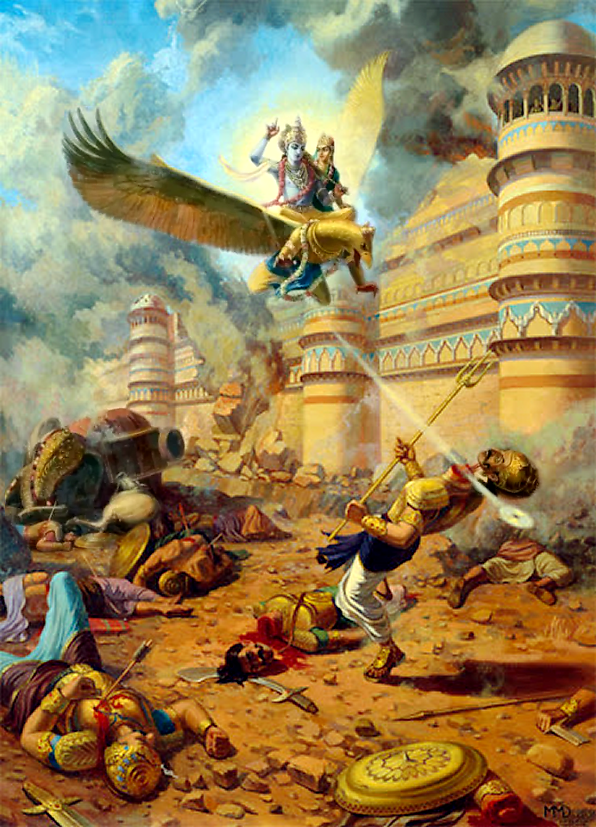
There were 16,100 beautiful girls who were daughters of many kings and were forcibly stolen by Bhaumasura, who kept them captive for his carnal desire. These girls prayed piteously to Lord Krishna for their deliverance, and the merciful Lord, called by their fervent prayer, released them all by fighting and killing Bhaumasura. (SB 1.10.29 purport)
It is already known to us that Kṛṣṇa had 16,108 wives. All these wives were exalted liberated souls, and among them Queen Rukmiṇī was the chief. After Rukmiṇī there were seven other principal wives, and the names of the sons of these eight principal queens have already been mentioned. Besides these eight queens, LORD KRSNA HAD TEN SONS WITH EACH OF THE OTHER QUEENS. Thus all together Kṛṣṇa’s children numbered 16,108 TIMES TEN. One should not be astonished to hear that Kṛṣṇa had so many sons.
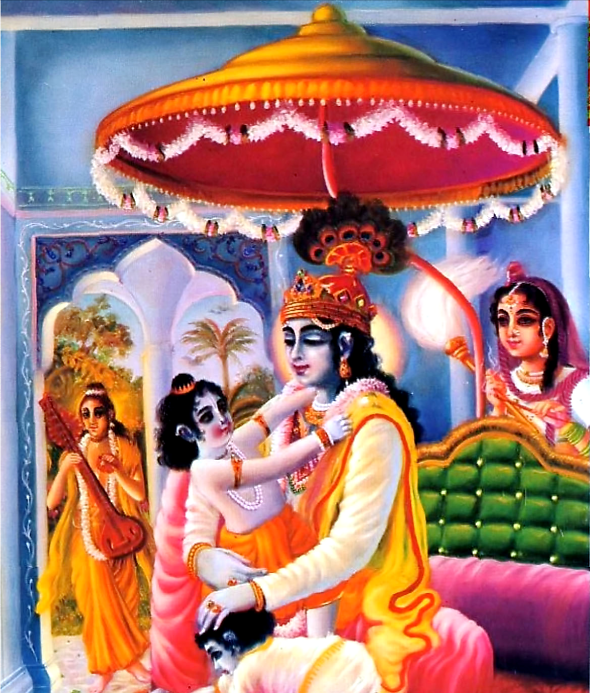
ONE SHOULD ALWAYS REMEMBER THAT KRSNA IS THE SUPREME PERSONALITY OF GODHEAD AND THAT HE HAS UNLIMITED POTENCIES. HE CLAIMS ALL LIVING ENTITIES AS HIS SONS. SO EVEN IF HE HAD SIXTEEN MILLION SONS ATTACHED TO HIM PERSONALLY THERE WOULD BE NO CAUSE FOR ASTONISHMENT.
It is stated by Śukadeva Gosvāmī that ALL the members of the Yadu dynasty had MANY children. Just as Kṛṣṇa had many sons, grandsons and great-grandsons, so EACH ONE OF THE KINGS named herewith also had SIMILAR FAMILY EXTENSIONS. Not only did all of them have many children, but all were extraordinarily rich and opulent. None of them were weak or short-lived, and above all, all the members of the Yadu dynasty were staunch devotees of the brahminical culture.
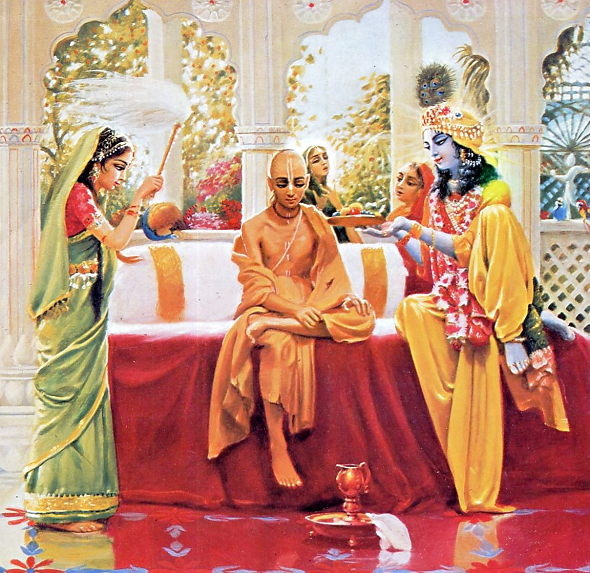
It is the duty of the kṣatriya kings to maintain the brahminical culture and to protect the qualified brāhmaṇas, and all these kings discharged their duties very rightly. The members of the Yadu dynasty were SO NUMEROUS that it would be very difficult to describe them all, even if one had a DURATION OF LIFE OF MANY THOUSANDS of years.
Śrīla Śukadeva Gosvāmī informed Mahārāja Parīkṣit that he had heard from reliable sources that simply TO TEACH THE CHILDREN of the Yadu dynasty, there were as many as 38,800,000 TUTORS OR ACARYAS. If so many teachers were needed to educate their children, one can simply imagine HOW VAST was the number of family members. As for their military strength, it is said that King Ugrasena alone had TEN QUADRILLION SOLDIERS AS PERSONAL BODYGUARDS.
Note:
One Quadrillion is 1.000.000.000.000.000 ( fifteen zeroes )
One billion is 1.000.000.000 ( 9 zeroes ) world population today roughly 8.000.000.000
16,108 Queens, 161,080 Sons, 900,000 Palaces, 38,800,000 Teachers and Ten Quadrillion Bodyguards alone for King Ugrasena ……… in NINETY SIX SQUARE MILES !
WOW
ONE MAY ASK HOW THIS WAS POSSIBLE, and Srila Viśvanātha Cakravartī Ṭhākura reminds us that Kṛṣṇa, although bound by a small rope, could show His mother the whole universe within His mouth. How was this possible? The answer is that He can do anything for the pleasure of His devotees.
THE TRANSCENDENTAL PASTIMES OF THE SUPREME PERSONALITY OF GODHEAD ARE SO POWERFUL THAT SIMPLY BY HEARING, READING AND MEMORISING THIS BOOK KRSNA, ONE IS SURE TO BE TRANSFERRED TO THE SPIRITUAL WORLD WHICH IS ORDINARILY VERY DIFFICULT TO ACHIEVE.
THE DESCRIPTION OF THE PASTIMES OF LORD KRSNA IS SO ATTRACTIVE THAT AUTOMATICALLY IT GIVES US AN IMPETUS TO STUDY REPEATEDLY, AND THE MORE WE STUDY THE PASTIMES OF THE LORD, THE MORE WE BECOME ATTACHED TO HIM. THIS VERY ATTACHMENT TO KRSNA MAKES ONE ELIGIBLE TO BE TRANSFERRED TO HIS ABODE, GOLOKA VRNDHAVANA.
All Glories to Srila Prabhupada !
Download PDF
http://www.prabhupada-zentrum.de/artikel/dvaraka/DwarakaHistory.pdf
http://www.prabhupada-zentrum.de/artikel/dvaraka/DwarakaHistory.doc
http://veda.wikidot.com/dwaraka
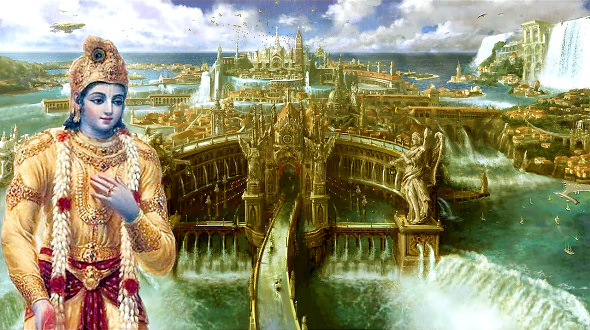
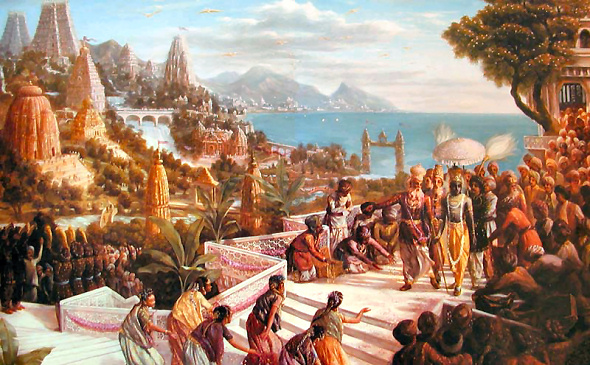
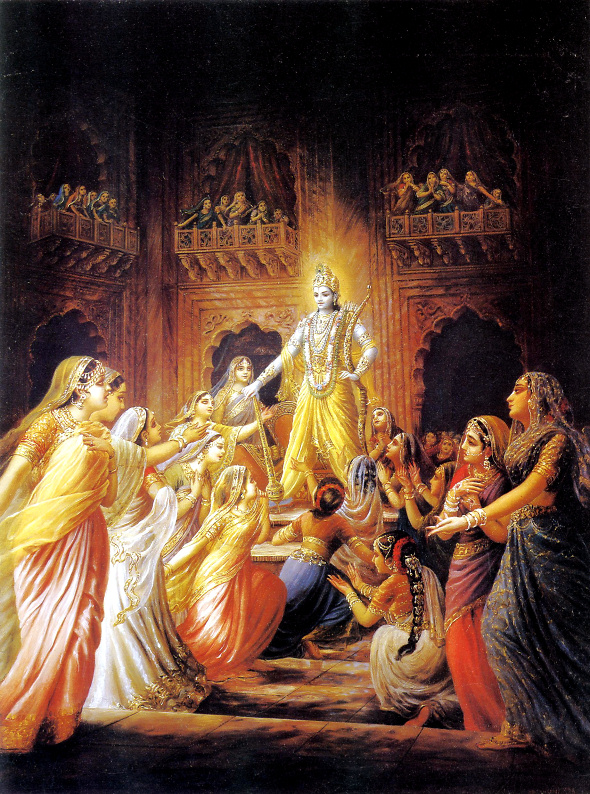
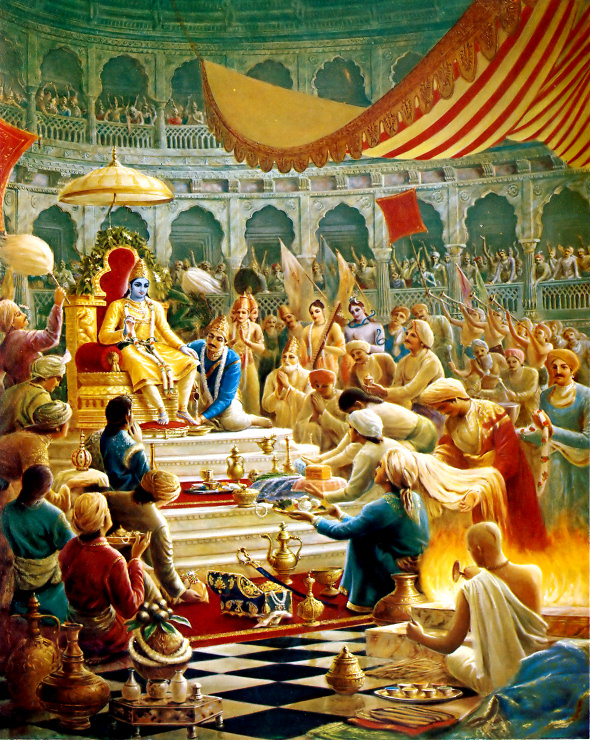
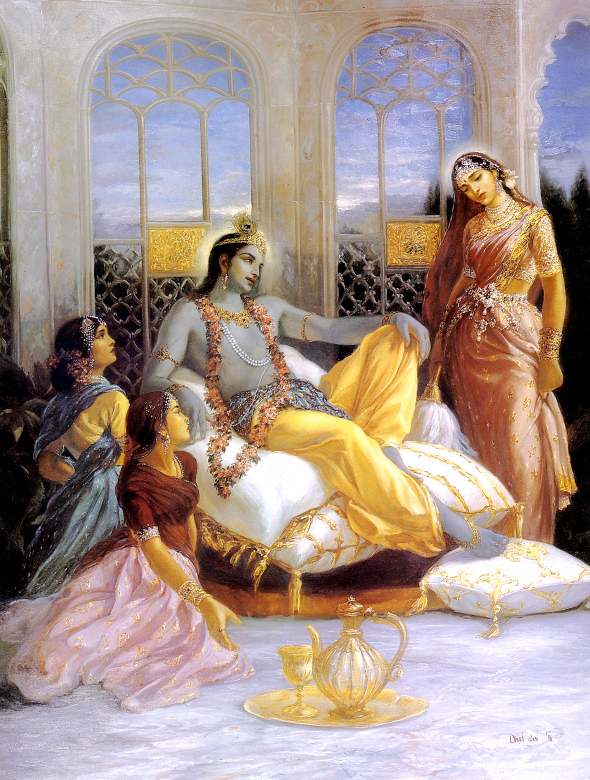
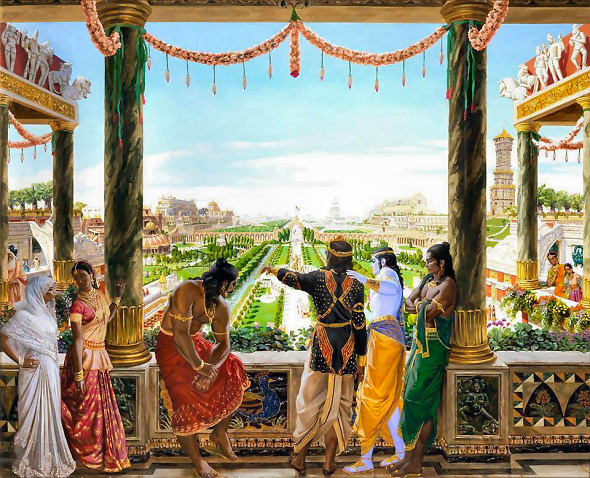
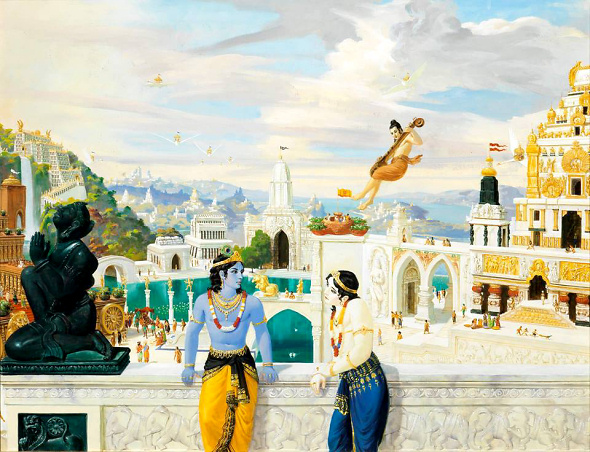







Mohini Devi Dasi:
Note:
One Quadrillion is 1.000.000.000.000.000 ( fifteen zeroes )
One billion is 1.000.000.000 ( 9 zeroes ) world population today roughly 8.000.000.000
16,108 Queens, 161,080 Sons, 900,000 Palaces, 38,800,000 Teachers and Ten Quadrillion Bodyguards alone for King Ugrasena ……… in NINETY SIX SQUARE MILES !
WOW
ONE MAY ASK HOW THIS WAS POSSIBLE, and Srila Viśvanātha Cakravartī Ṭhākura reminds us that Kṛṣṇa, although bound by a small rope, could show His mother the whole universe within His mouth. How was this possible? The answer is that He can do anything for the pleasure of His devotees.
THE TRANSCENDENTAL PASTIMES OF THE SUPREME PERSONALITY OF GODHEAD ARE SO POWERFUL THAT SIMPLY BY HEARING, READING AND MEMORISING THIS BOOK KRSNA, ONE IS SURE TO BE TRANSFERRED TO THE SPIRITUAL WORLD WHICH IS ORDINARILY VERY DIFFICULT TO ACHIEVE.
THE DESCRIPTION OF THE PASTIMES OF LORD KRSNA IS SO ATTRACTIVE THAT AUTOMATICALLY IT GIVES US AN IMPETUS TO STUDY REPEATEDLY, AND THE MORE WE STUDY THE PASTIMES OF THE LORD, THE MORE WE BECOME ATTACHED TO HIM. THIS VERY ATTACHMENT TO KRSNA MAKES ONE ELIGIBLE TO BE TRANSFERRED TO HIS ABODE, GOLOKA VRNDHAVANA.
Mahesh: In one tape there were some “devotees” arguing with Srila Prabhupada over this issue. They had no faith. They could not believe this:
750626rc.la
Devotee (2): Not Kṛṣṇa. No. King Ugrasena, Prabhupāda. Not Kṛṣṇa. King Ugrasena. The statement is that King Ugrasena had four billion personal servants. Now, we have gone and tried to spread to the scientific community. And if we say to them, “There was a king whose name was Ugrasena. He had four billion personal servants,” they laugh and say, “What did they do for toilets? What did they do for food? Where did they live?”
Prabhupāda: So you want to preach this particular portion and no other portion?
Devotee (1): No. We want to… We want to know if the story has an allegorical meaning rather than a literal translation, or that King Ugrasena who was a man who lived five thousand years ago and had four billion bodyguards, or whether the stories within the Bhāgavatam, apart from some of them being actual, are allegorical stories. Such as the story of Kṛṣṇa and Balarāma chopping off the the eighty-eight…
Prabhupāda: All right. You can give up that portion. You can take other portion.
Devotee (2): We don’t mean to give it up.
Devotee (1): We don’t mean to give it up.
Devotee (2): We’re saying how can we say to them…
Prabhupāda: Anyone, anyone… Why you are going to preach that portion to a professor?
Devotee (1): No. When they read your books, they pose that question to us.
Devotee (2): They read it. They say to us.
Devotee (1): And unless we can answer that question…
Prabhupāda: They ask to only you, but they never ask to us.
Revatīnandana: They have. Sometimes they ask me.
Prabhupāda: That’s all right. Let them ask. But you can tell away that(?) but you don’t repeat this thing. You can give up that portion. You read other portion.
Devotee (1): But then because so many things they have to accept on faith without knowing, it then weakens their faith as to what they should accept and why should they accept Kṛṣṇa, who they can’t see any more than King Ugrasena’s four billion bodyguards.
Prabhupāda: Don’t accept. Don’t accept.
Devotee (2): But we want them to accept. The point is, if we say to a scientific man, “There was four billion,” and if our statement is wrong…
Prabhupāda: But our position is that if some portion we cannot understand, it is our incapability.
Devotee (2): That is all right. But since we are…
Prabhupāda: That’s all. Unless we have got this faith we cannot use these Purāṇas. In the Purāṇas there are many such statements.
Devotee (2): Yes, but we just want to understand.
Prabhupāda: Therefore many people, they do not accept Purāṇas. So what can be done?
Devotee (2): We’re just trying to understand it because we’ve never dealt with Purāṇas before. We have been your disciples. But when we present this to the scientific community, because you have said that if one word is wrong, the whole philosophy is wrong, so they will say to us…
Prabhupāda: So let them take it and throw out, don’t read it. That’s all.
Devotee (2): But then they discredit the Bhagavad-gītā. We don’t like that when they discredit the Bhagavad-gītā.
Prabhupāda: Why? They don’t believe. What is the use?
Devotee (2): Well, because we also want to know how did they have four billion personal servants just so that we’ll be able to convince them and also…
Prabhupāda: If a king has four billion servants, so it is not very astonishing. Why do you think that a king shall have only four servants?
Devotee (2): Well, there’s only two billion people on the planet right now.
Prabhupāda: That’s all right.
Devotee (2): So where did they all go?
Prabhupāda: I say you don’t believe, you don’t take it. Why you are insisting on that point? If you don’t believe, you don’t take it. If you don’t believe the whole book or the whole society, then who forbids you?
Devotee (2): We were hoping that there are some things which can be improved, because they have not been set up by you.
Prabhupāda: No. You cannot improve. Whatever we are, we are.
Devotee (2): Why can we not improve it?
Prabhupāda: No. There is no possibility.
Devotee (2): Then what is the use of action?
Prabhupāda: Action, whatever action we can do by chanting Hare Kṛṣṇa, that’s all.
Devotee (2): But we also have to make varṇāśrama society or farms or businesses.
Prabhupāda: That, when we shall do, we shall see to it.
Devotee (2): But we are doing it. We are.
Devotee (1): We are doing it now, and that’s the question…
Prabhupāda: So do it in your own way.
Devotee (2): We don’t want to. We want to do everything Kṛṣṇa’s way.
Prabhupāda: Stop it. Stop it. I say stop it. You have come to me for my advice. I say you stop it.
Devotee (2): Then, we say, what should we do?
Prabhupāda: You should do your business. That’s all. Earn money and enjoy.
Devotee (2): No, I mean what should we do Kṛṣṇa consciously?
Prabhupāda: You give up Kṛṣṇa consciousness, I say. That is my advice.
Devotee (2): Why should we do that?
Prabhupāda: Then that I cannot say.
Devotee (1): Isn’t there a middle of the road?
Prabhupāda: If you are finding so many faults, you give it up.
Devotee (1): No. We’re not finding fault.
Prabhupāda: Then there is no other advance, alternative. No alternative. Either you accept or reject it.
++++++++++++++++++++++++++++++++++++++
Note: Lord Krsna is MASTER of ALL mystics: yatra yogeśvaraḥ kṛṣṇo. Lord Krsna being the Supreme Personality of Godhead CAN do ANYTHING and His PURE devotees are also empowered by Him:
TEXT 78
yatra yogeśvaraḥ kṛṣṇo
yatra pārtho dhanur-dharaḥ
tatra śrīr vijayo bhūtir
dhruvā nītir matir mama
SYNONYMS
yatra—where; yogeśvaraḥ—the master of mysticism; kṛṣṇaḥ—Lord Krṣna; yatra—where; pārthaḥ—the son of Pṛthā; dhanur-dharaḥ—the carrier of the bow and arrow; tatra—there; śrīḥ—opulence; vijayaḥ—victory; bhūtiḥ—exceptional power; dhruvā—certainly; nītiḥ—morality; matiḥ mama—is my opinion.
TRANSLATION
Wherever there is Kṛṣṇa, the master of all mystics, and wherever there is Arjuna, the supreme archer, there will also certainly be opulence, victory, extraordinary power, and morality. That is my opinion.
+++++++++++++++++++++++++++++++++++++++++++++++++++
Note: yogi can create even a planet:
Here the words yogam āsthitaḥ are significant. The sage Kardama was completely perfect in yoga. As the result of real yoga practice there are eight kinds of perfection: the yogī can become smaller than the smallest, greater than the greatest or lighter than the lightest, he can achieve anything he likes, he can create even a planet, he can establish influence over anyone, etc. In this way yogic perfection is achieved, and after this one can achieve the perfection of spiritual life. Thus it was not very wonderful for Kardama Muni to create a mansion in the air, according to his own desire, to fulfill the desire of his beloved wife. He at once created the palace, which is described in the following verses.
Link to this page: https://prabhupadabooks.com/sb/3/23/12
King Ugrasena had 10 quadrillion, 10.000.000.000.000.000 bodyguards. Now here is the example of King Nagnajit giving dowry in similar proportions.
KB CHAPTER FIFTY-EIGHT
Five Queens Married by Kṛṣṇa
After this incident, Kṛṣṇa married the daughter of the King of Kośala. The king of Kośala province was called Nagnajit. He was very pious and was a follower of the Vedic ritualistic ceremonies. His most beautiful daughter was named Satyā.
…..King Nagnajit continued his request: “Kṛṣṇa, if You’ll kindly bridle the seven bulls and bring them under control, then undoubtedly You will be selected as the desired husband of my daughter, Satyā.” After hearing this statement, Kṛṣṇa could understand that the King did not want to break his vow. Thus, in order to fulfill his desire, He tightened His belt and prepared to fight with the bulls. He immediately divided Himself into seven Kṛṣṇas, and each one of Them immediately caught hold of a bull and bridled its nose, thus bringing it under control as if it were a plaything.
When Kṛṣṇa brought the bulls under His control by bridling their noses, their strength and pride were immediately smashed. The name and fame which the bulls had attained was thus vanquished. When the bulls had been bridled by Kṛṣṇa, He pulled them strongly, just as a child pulls a toy wooden bull. Upon seeing this advantage of Kṛṣṇa, King Nagnajit became very much astonished and immediately, with great pleasure, brought his daughter Satyā before Kṛṣṇa and handed her over to Him. Kṛṣṇa also immediately accepted Satyā as His wife. Then there was a marriage ceremony with great pomp.
First of all he gave them 10,000 cows and 3,000 well-dressed young maidservants, ornamented up to their necks. This system of dowry is still current in India especially for kṣatriya princes. Also, when a kṣatriya prince is married, at least a dozen maidservants of similar age are given along with the bride. After giving the cows and maidservants, the King also enriched the dowry by giving 9,000 elephants and a hundred times more chariots than elephants. This means that he gave 900,000 chariots. And he gave a hundred times more horses than chariots, or 90,000,000 horses, and a hundred times more slaves than horses.
A hundred times more slaves than horses 90,000,000 ( 90 million horses )
90,000,000 x 100 = 9,000,000,000 makes 9 billion slaves which accompanied Lord Krsna and Satya to Dvaraka. Plus all the …elephants,… horses, …chariots,… cows and …girlfriends. And that’s from just one mortal king !
…After this, the chief of the Yadu dynasty, Lord Krsna, along with his newly married wife and a HUGE DOWRY, entered the city of Dvaraka with great pomp…
The inconceivable is called ” acintya”, that which is beyond “cintya”i.e. our thoughts and arguments.
” Acintya ” refers to that which we cannot contemplate but have to accept. ”
” Cintya ” point of views, all the Holy Dhamas i.e. Vrindaban, Navadveep dham, Ayudiya and Dawarka and so on are indeed still in existence.
When we read and understand from the KB. the description of the City of Dawarka and the Opulences described there in, the glory of Dawarka and others Holy Dhamas are “acintya “, indeed.
The description is beyond the realm of our conception of understanding and forming a thoughts as to how such a huge descriptions of events did exist in the past.
Therefore, the Wise takes and accepts the words of the Sastra without change, since they are beyond our arguments.
To think even these events took place are myths per se shows lack of or no intelligence at all because these places do exist on the land of Bharata versha.
OM TAT SAT.
Hare Krishna. All Glories to Srila Prabhupada.
Yes, Amar Puri Prabhu, of course you are right when you say:
When we read and understand from the KB. the description of the City of Dawarka and the Opulences described there in, the glory of Dawarka and others Holy Dhamas are “acintya “, indeed.
The description is beyond the realm of our conception of understanding and forming a thoughts as to how such a huge descriptions of events did exist in the past.
Therefore, the Wise takes and accepts the words of the Sastra without change, since they are beyond our arguments.
Here is a superbly fitting purport by Srila Prabhupada to exactly the topic of UNLIMITED NUMBERS.
10.12.3 The Killing of the Demon Aghasura
Translation:
Along with the cowherd boys and their own group of calves, Krsna came out with an unlimited number of calves assembled. Than all the boys began to sport in the forest in a greatly playful spirit.
Purport:
In this verse the words krsna-vatsair asankyataih are significant. The word asankyataih means unlimited. We may speak of hundreds, thousands, tens of thousands, hundreds of thousands, millions, billions, trillions, tens of trillions, and so on, but when we go further to speak of NUMBERS IMPOSSIBLE FOR US TO COUNT, we are speaking of UNLIMITED numbers. Such unlimited numbers are indicated hereby the word asankyataih. Krsna is unlimited, His potency is unlimited, His cows and calves are unlimited, and His SPACE is unlimited. Therefore He is described in the Bhagavad-gita as Parabrahman. The word brahman means “unlimited,” and Krsna is the Supreme Unlimited, Parabrahman. THEREFORE WE SHOULD NOT CONSIDER THE STATEMENTS OF THIS VERSE TO BE MYTHOLOGICAL. They are FACTUAL but INCONCEIVABLE. Krsna can accommodate an unlimited number of calves and an UNLIMITED MEASUREMENT OF SPACE. This is neither mythological nor false, but if we study Krsna’s potency with our limited knowledge, that potency will never be possible to understand. Atah Sri-Krsna-namadi na bhaved grahyam indriyaih [ Bhakti-rasamrta-sindhu 1.2.109 ]. Our senses cannot perceive how He could keep an UNLIMITED NUMBER of calves and cows and have UNLIMITED SPACE to do so. But this is answered in the Brhad-bhagavatamrta:
evam prabho pryanam ca
dhamnas ca samayasya ca
avicintya-prabhavatvad
atra kincin na durghatam
Sri Sanatana Gosvami, in the Brhad-bhagavamrta, states that since everything about Krsna is unlimited, nothing is impossible for Him. It is in this sense that we have to understand this verse.
All Glories to Srila Prabhupada!
KRSNA BOOK 10.13.57 Brahma Stealing the Boys and Calves
…Brahma was mystified about Krsna’s opulence (nija-mahimani) because this opulence was atarkya, or inconceivable. WIth one’s limited senses, one cannot argue about that which is inconceivable. Therefore the inconceivable is called acintya, that which is beyond cintya, our thoughts and arguments. Acintya refers to that which we cannot contemplate but have to accept.
Srila Jiva Gosvami has said that unless we accept acintya in the Supreme, we cannot accommodate the conception of God. This must be understood. Therefore we say that the words of sastra should be taken as they are, without change, since they are beyond our arguments. Acintya khalu ye bhava na tams tarkena yoyajet: “That which is acintya cannot be ascertained by argument.” People generally argue, but our process is not to argue but to accept the Vedic knowledge as it is.
When Krsna says,” This is superior, and this is inferior,” we accept what He says. It is not that we argue, “Why is this superior, and this is inferior?” If one argues, for him the knowledge is lost.
Everyone wants to take pleasure in his own knowledge, thinking, ” I know something.” But in the presence of Krsna this conception cannot stand, for one cannot bring Krsna within the limitations of prakrti. One must submit. There is no alternative. Na tams tarkena yoyajet. This submission marks the difference between Krsna-ites and Mayavadis….
Note:
731202SB.LA
The queens of Kṛṣṇa, they could not be touched. But it is a play only. Similarly, Yadu dynasty, the descendants of Kṛṣṇa, they also could not be killed. But… Just like Kṛṣṇa was killed by the arrow of a hunter. How Kṛṣṇa can be killed? But it is for the persons, FOR THE DEMONS, to demonstrate like that, who thinks Kṛṣṇa as ordinary human being. So FOR THEM IT IS A JUGGLERY. They will still know that “Here your Kṛṣṇa is killed.” Yes. They will say like that. So tān ahaṁ dviṣataḥ krūrān kṣipāmy ajasram asura-yoniṣu [Bg. 16.19]. The demons, as they want to forget Kṛṣṇa, or they do not like to understand Kṛṣṇa as the Supreme Personality of Godhead, Kṛṣṇa PLAYS something like that so that they will be MORE CONVINCED that Kṛṣṇa is not God, Kṛṣṇa is ordinary human being. Tān ahaṁ dviṣataḥ krūrān. They will remain in darkness forever. Kṛṣṇa gives chance to everyone. If you want to forget Kṛṣṇa, Kṛṣṇa will give you such intelligence, you will talk so intelligently that “Kṛṣṇa is not God.” Ye yathā māṁ prapadyante [Bg. 4.11]. And if you want to know Kṛṣṇa, then He will give you such intelligence, you will know that “Here is Supreme Personality of Godhead.” This is Kṛṣṇa’s busin… If you want to forget Kṛṣṇa, Kṛṣṇa will give you chance to forget Him forever. And you suffer. Because forgetting Kṛṣṇa, one is not benefited. By knowing Kṛṣṇa is one benefited. But the demons, rākṣasas, they suffer, and still they want to forget Kṛṣṇa. This is their business.
++++++++++++++++++++++++++++++++++++++++++++++++++++++++++
731202SB.LA
The story is that Yadu-vaṁśa, the dynasty of Kṛṣṇa… Kṛṣṇa had 16,108 wives, and each wife had ten sons, and each son had another ten sons. In this way the whole family was composed of hundreds and thousands of men, Yadu dynasty. And when Kṛṣṇa came, so to assist Him, all these demigods, they came to help Him, līlā. Just like if you play something dramatic, you require so many assistants, so when Kṛṣṇa comes, those who are devotees of Kṛṣṇa, they also come to assist Him. Somebody becomes His father, somebody His mother, somebody His friend, somebody His wife, somebody His son, some grandson, like that. So when Kṛṣṇa wanted to depart from this planet, He wanted to take away all others also along with Him. So these are simply material, external causes. Actual fact is Kṛṣṇa, as He went away, He wanted to take all the associates under different pleas.
So it is explained in the Bhāgavatam that queens, the were they not actually… Nobody can touch them. Just like Sītā. Sītā was kidnapped by Rāvaṇa. How it is possible that Sītā can be kidnapped by a demon? No. That is stated in the Caitanya-caritāmṛta, that Lord Caitanya, He was a guest of a brāhmaṇa in South India. So He took His bath and came to the house of that brāhmaṇa, but the brāhmaṇa did not arrange for any cooking even. There was no food. He was very sorry. So Caitanya Mahāprabhu inquired, “Brāhmaṇa, you invited Me, but I don’t see even you have cooked. What is the reason?” “Oh, yes, I am going to cook immediately. The thing is, I am very sorry that Rāvaṇa, the demon, has taken away Sītā, and I could not rescue her still. So why shall I eat? I shall die.” He was in the ecstasy of Hanumān, a devotee. He was thinking like Hanumān. So Caitanya Mahāprabhu very much liked that he is, in devotion and in ecstasy of Hanumān, he is thinking like that. So at that time Caitanya Mahāprabhu said, “So don’t be sorry. Sītā, Lakṣmījī, she cannot be touched by Rāvaṇa. It was māyā Sītā, māyā Sītā. I will tell you. I will give you evidence from the śāstra.” So brāhmaṇa believed Him because Caitanya… “Oh, she is there? Sītā was not taken? A māyā Sītā was taken?” “Yes.” Then he become encouraged. He cooked and sufficiently gave Him food.
So by chance, when Caitanya Mahāprabhu was touring in South India… The Purāṇas, Śiva Purāṇa or something like that, it is stated there. And He brought the evidence again, that “Here you see, in the Purāṇa it is said that when Rāvaṇa came to kidnap Sītā, immediately a false Sītā was given to him, and the real Sītā disappeared. Then again, when Lord Rāmacandra, after killing Rāvaṇa, He was accepting Sītā back to home, He tested with fire, that ‘Sītā, you should enter the fire, and if you are not burned, then you are chaste. Otherwise you are not chaste.’ Yes. So the false Sītā which was taken by Rāvaṇa, she entered the fire, and the real Sītā came out.” This is the statement in the śāstra.
So things take place like that. The queens of Kṛṣṇa, they could not be touched. But it is a play only. Similarly, Yadu dynasty, the descendants of Kṛṣṇa, they also could not be killed. But… Just like Kṛṣṇa was killed by the arrow of a hunter. How Kṛṣṇa can be killed? But it is for the persons, for the demons, to demonstrate like that, who thinks Kṛṣṇa as ordinary human being. So for them it is a jugglery. They will still know that “Here your Kṛṣṇa is killed.” Yes. They will say like that. So tān ahaṁ dviṣataḥ krūrān kṣipāmy ajasram asura-yoniṣu [Bg. 16.19]. The demons, as they want to forget Kṛṣṇa, or they do not like to understand Kṛṣṇa as the Supreme Personality of Godhead, Kṛṣṇa plays something like that so that they will be more convinced that Kṛṣṇa is not God, Kṛṣṇa is ordinary human being. Tān ahaṁ dviṣataḥ krūrān. They will remain in darkness forever. Kṛṣṇa gives chance to everyone. If you want to forget Kṛṣṇa, Kṛṣṇa will give you such intelligence, you will talk so intelligently that “Kṛṣṇa is not God.” Ye yathā māṁ prapadyante [Bg. 4.11]. And if you want to know Kṛṣṇa, then He will give you such intelligence, you will know that “Here is Supreme Personality of Godhead.” This is Kṛṣṇa’s busin… If you want to forget Kṛṣṇa, Kṛṣṇa will give you chance to forget Him forever. And you suffer. Because forgetting Kṛṣṇa, one is not benefited. By knowing Kṛṣṇa is one benefited. But the demons, rākṣasas, they suffer, and still they want to forget Kṛṣṇa. This is their business.
So now the most important thing is that Kṛṣṇa made this plan to kill His descendants. He did not like that they should, but who will kill them? That is the problem. They are descendants of Kṛṣṇa. Who will kill them? Therefore it was Kṛṣṇa’s plan that they will kill themselves. If others come to kill Kṛṣṇa’s descendants, then what is the value of Kṛṣṇa’s descendants? Nobody could kill, because in Kṛṣṇa’s presence, whenever there was fight, all the descendants they came out… And who will conquer them? Nobody. That is not possible. But Kṛṣṇa wanted that before His going away, all these demigods, they must also return. “Return” means this body must be killed. But who will kill them? That was the plan of Kṛṣṇa. Therefore Kṛṣṇa is… Īśvaraḥ sarva-bhūtānāṁ hṛd-deśe ‘rjuna tiṣṭhati [Bg. 18.61]. He is planning. He made this plan.
So what is that? One of them made a false pregnancy with a stone on the belly wrapped with cloth, and another boy or another man, he went to a ṛṣi that “Sir, can you tell what is child in the womb of this woman?” She is not woman, she is man. So the saintly person could understand that “These people have come to joke me.” So he immediately cursed—vipra—that “Yes, what is there in the womb, that will be the cause of destroying your whole family.” So when they were cursed, the came to their senses: “What you have done?” So actually, it was a stone. So they began to rub the stone so that there will be no existence of the stone. Rubbing, rubbing, rubbing, rubbing—that pulp and water, that was distributed, and all of them became sticks. So then, after that, they became intoxicated, and they could not understand amongst themselves who is friend, who is enemy, and took those sticks and began to beat one another. In this way they died. This is the story. You know It is stated in the Kṛṣṇa book.
So our point is to know this is a play only, background. Actually, Kṛṣṇa wanted to take them away. And nobody could kill them. Therefore He planned a killing plan amongst themselves. This is the fact. But we should know that vipra-śāpa-vimūḍhānām: if any person is cursed by vipra, brāhmaṇa, Vaiṣṇava, then they are finished. Therefore according to the Vedic civilization, brāhmaṇas and Vaiṣṇavas are always honored so that they may not be dissatisfied. This is the rule. Brāhmaṇa and Vaiṣṇava. The devotees and the brāhmaṇas. Veda-pāṭhād bhaved vipro brahma jānātīti brāhmaṇaḥ. Those who are spiritually advanced, such persons should not be offended. Then you are finished in according to our philosophy, vaiṣṇava-aparādha… Just we were talking in our walking that a great yogi… What is the name?
Pamho agtacbsp, Viswakarma deva built dwaraka in 24 hours and the real wife of Sri krsna was 8, He married all the others to save them from the bad reputation of the demon when He make them free from the jail, but at the end He rape and robbed some queen at gopi kunda because of the curse of the sadhu, Arjuna couldn’t do nothing to protect them because the robbers were all krsna, I been there I did the dwaraka tour that’s rukmini dwarakadisha ,gopi kunda, bet dwaraka the small island where the palace sudharma used to be the place for meeting with Sri krsna ,whoever was getting inside was free from the samsara,Dwaraka is in aiswarya opulence and only Sri krsna could do that, is not surprising that everything disappeared with Sri krsna I mean the wonderful dwaraka including His sons the yadhu dynasty ended in prabhasa ksetra today is called somnath,we just enjoy to remember this nice lila of Yadhunath and Srila prabhupada used to say that if Sri krsna is lusty is unlimited lusty Sri dwaraka exist eternally mathura puri and dwaraka puri are a eternal pastime didn’t finish with the disappearance from this mortal world of living dead ,all glories to the amazing lila of Sri krsna bhagavat the supreme personality of godhead ki Jay agtacbsp ys haribol
Dear Learned Readers,
PAMHO.
Wow ……. This is indeed the True import of Srila Prabhupada’s VANI…….. Simply wonderful. One must learn to accept it As It Is the Transcendental Knowledge coming to us in the disciplic succession from the Lord Shri Krishna Himself.
His Divine Grace Srila Prabhupada has given us the King of the Knowledge Shri Shri Granth Raja Srimad Bhagavat Gita As It Is spoken by the fountain head of the Lotus Mouth of the Creator of all Creators Lord Shri Krishna Himself to one of His best Student who is also one of the best Warrior Shri Arjuna to teach the Science of God Realization to all the Living Entities in the Universe to bring them ( all of us ) back Back to Godhead. That is the Power of Srila Prabhupada’s Original BOOK.
During the conversation of Srila Prabhupada to His disciples on Krsna Book as quoted by Shriman Mahesh Raja, the devotees could not understand what is written in the Krsna Book by Srila Prabhupada. At one point, we note during the conversation, Srila Prabhupada ask them to stop questions because they could not have the understanding to develop a FAITH in order to accept the Transcendental Knowledge written in the Krsna Book. Srila Prabhupada never allowed to come to the middle point so that people in general could have faith making the story as an allegorical.
Now we see it, after the manifested Lila of Srila Prabhupada , the disciples in-charge took over Srila Prabhupada’s mission and brought so many changes not only in His BOOKS but in His established Systems also. As a result of it, there are split in the Srila Prabhupada Hare Krsna Movement. Those of us who have unflinching faith in the Srila Prabhupada’s VANI are known now Prabhupadanugas’ groups who carry Srila Prabhupada’s Original message in the Books and System As It was during His Manifested Lila to propagate His Mission world wide.
That is the only way the followers, students, devotees of Srila Prabhupada shall carry forward Srila Prabhupada Mission As It Is for the rest of the remaining 10,000 years world wide.
All Glories to Srila Prabhupada and His Sincere Students, Followers and Devotees world wide.
OM TAT SAT.
Note: these so-called devotees did not have faith in Srila Prabhupada. As we see in ISKCON, Anti Ritvik CROOKS who oppose July 9th 1977 Direct Order for Ritvik System are just cheaters: they actually have no faith in Srila Prabhupada. Here is one example of faith:
There are two kinds of energy—material and spiritual. Jīvas, or individual souls, belong to the superior energy of Kṛṣṇa, but because they are prone to be attracted to the material energy, they are called marginal energy. But actually there are only two energies. All of the planetary systems and universes are resting on the energies of Kṛṣṇa. Just as all the planets in the solar system are resting in the sunshine, everything within the creation is resting on Kṛṣṇa-shine. All of these potencies of the Lord give pleasure to a devotee, but one who is envious of Kṛṣṇa rejects them. When one is a nondevotee, the statements of Kṛṣṇa seem to be so much bluff, but when one is a devotee, he thinks, “Oh, my Lord is so powerful,” and he becomes filled with love and adoration. Nondevotees think that because Kṛṣṇa says, “I am God,” they and everyone else can say the same. But if asked to show their universal form, they cannot do it. That is the difference between a pseudo god and the real God. Kṛṣṇa’s pastimes cannot be imitated. Kṛṣṇa married over 16,000 wives and kept them nicely in 16,000 palaces, but an ordinary man cannot even keep one wife nicely. It is not that Kṛṣṇa just spoke so many wonderful things; He also acted wonderfully. We should not believe one thing that Kṛṣṇa says or does and reject another; if belief is there, it must be full belief.
In this regard, there is a story of Nārada Muni, who was once asked by a brāhmaṇa: “Oh, you are going to meet the Lord? Will you please ask Him when I’m going to get my salvation?”
“All right,” Nārada agreed. “I shall ask Him.”
As Nārada proceeded, he met a cobbler who was sitting under a tree mending shoes, and the cobbler similarly asked Nārada, “Oh, you are going to see God? Will you please inquire of Him when my salvation will come?”
When Nārada Muni went to the Vaikuṇṭha planets, he fulfilled their request and asked Nārāyaṇa (God) about the salvation of the brāhmaṇa and the cobbler, and Nārāyaṇa replied, “After leaving this body, the cobbler shall come here to me.”
“What about the brāhmaṇa?” Nārada asked.
“He will have to remain there for a number of births. I do not know when he is coming.”
Nārada Muni was astonished, and he finally said, “I can’t understand the mystery of this.”
“That you will see,” Nārāyaṇa said. “When they ask you what I am doing in My abode, tell them that I am threading the eye of a needle with an elephant.”
When Nārada returned to earth and approached the brāhmaṇa, the brāhmaṇa said, “Oh, you have seen the Lord? What was He doing?”
“He was threading an elephant through the eye of a needle,” Nārada answered.
“I don’t believe such nonsense,” the brāhmaṇa replied. Nārada could immediately understand that the man had no faith and that he was simply a reader of books.
Nārada then left and went on to the cobbler, who asked him, “Oh, you have seen the Lord? Tell me, what was He doing?”
“He was threading an elephant through the eye of a needle,” Nārada replied.
The cobbler began to weep, “Oh, my Lord is so wonderful, He can do anything.”
“Do you really believe that the Lord can push an elephant through the hole of a needle?” Nārada asked.
“Why not?” the cobbler said, “Of course I believe it.”
“How is that?”
“You can see that I am sitting under this banyan tree,” the cobbler answered, “and you can see that so many fruits are falling daily, and in each seed there is a banyan tree like this one. If, within a small seed there can be a big tree like this, is it difficult to accept that the Lord is pushing an elephant through the eye of a needle?”
So this is called faith. It is not a question of blindly believing. There is reason behind the belief. If Kṛṣṇa can put a large tree within so many little seeds, is it so astounding that He is keeping all the planetary systems floating in space through His energy?
Link to this page: https://prabhupadabooks.com/rv/3
Nice Video über Dvaraka
https://drive.google.com/file/d/0B3q_WrDluDbHV2JvV1NWeXUzbk0/edit?resourcekey=0-uSsCyMa5O9JUHRYl_t30nw
Very informative video which speaks the TRUTH itself.
There are people who seek the TRUTH and there are people who deny the TRUTH. So, the Lord, sitting as the Paramatma ( the Knower of everything ) in the heart of people gives the opportunity to all of us in knowing and understanding the TRUTH according to the degree of the desire in the FAITH of the Seeker.
Therefore, according to your sincere DESIRE, it is done unto you.
For those who wants proof of the TRUTH, the proof is also there but you need the eyes to see it. A wise person can see the TRUTH in a both Gross and Subtle forms. In a Gross Form is seeing with the eyes and the Subtle Form is seeing through the proper knowledge and understanding of it. For an example per se is the narrator in the Video. He believes that there is a TRUTH and he sets out for the journey to discover the TRUTH.
From the Sastra point of view, we see that the Vedic Civilization was very advance in the ancient time. Of this, there is no doubt about it for the wise person to understand it. However, there are persons who manipulate everything to present their Supremacy to the people in general simply for the Power and Control over everything. That is also there.
We see this at the present situation world wide, Control and Manipulate Everything. Control the Weather ( through the Technology by the Govt. Agency DARPA and HAARPA ) and Manipulate the News through the Main Stream Media world wide. Hide the TRUTH for a complete CONTROL. This is going on for centuries.
For an example, within an half of a century, the Hare Krishna Movement world wide have been hijacked and totally manipulated simply for a POWER to control over the movement. Is it NOT a FACT ? Who can deny it ? Only those who are FOOL do not accept the TRUTH.
Similarly, the Ancient Vedic Civilization have been manipulated simply for a complete control. However, by the Grace of the Lord, the Almighty Father Shri Krishna, through His Representative His Divine Grace Srila Prabhupada and the sincere Followers / Devotees world wide carry forward the Hare Krishna Movement As It Is with the tradition and the knowledge of the Ancient Vedic Civilization present in the Srila Prabhupada’s VANI to this age of time for the next 9,500 years to come.
Wishing all the Sincere Seekers of the Absolute TRUTH simply to follow through the bona fide Spiritual Master His Divine Grace Srila Prabhupada’s VANI and distribute the Vedic Civilization of TRUTH to make life blissful and sublime in cultivating Krishna Consciousness.
OM TAT SAT.
Hare Krishna. All Glories to Srila Prabhupada.